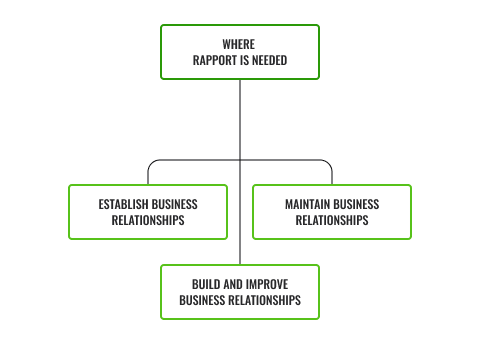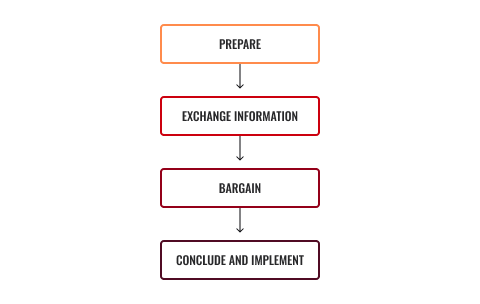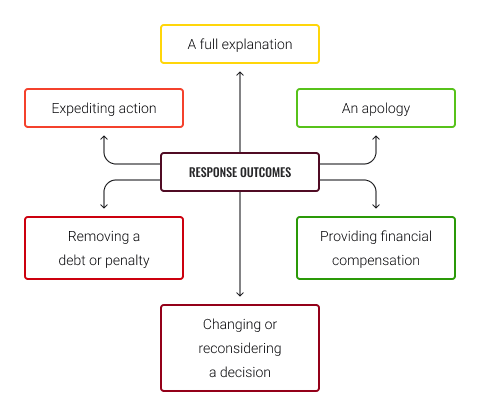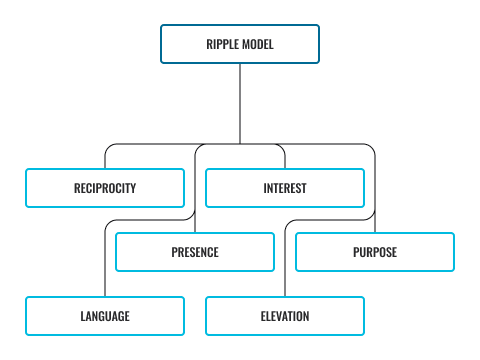When we think of negotiations, we may associate them with resolving a conflict. This is because the term 'conflict negotiation' appears frequently in the media. Before we continue, let us briefly discuss the intersect between 'conflict' and 'negotiation'.
Conflict often occurs when individuals in an organisation have different ideas, beliefs or theories regarding business operations. Conflict may also be experienced by business owners and managers when they are bargaining or negotiating with individuals or other organisations. Negotiation is the process of discussing each individual’s position about a topic and attempting to reach a solution that benefits both parties. Conflict and negotiation are usually more prevalent in larger business organisations since more individuals are involved in the company’s operations1. You can see from this description that conflict is not necessarily a negative experience but can point to a situation where problem-solving techniques may be required to negotiate a solution to an identified situation, problem or issue.
Negotiations can occur at different levels of complexity in an organisation.
Business negotiations
Business negotiations refer to a process or dialogue between two or more ‘parties’ representing an organisation or organisations. For example, when one business negotiates a sale of their business to another entity. They will have their own needs, interests, objectives, and views and are seeking to find a common ground and mutual understanding about a matter of mutual concern or interest. In a business context, and at its most basic, business negotiations are generally negotiations between ‘corporate entities, their vendors or their employees2.
Workplace negotiations
As humans, we negotiate on a daily basis, at home and at work. There are three main business contacts with whom you will regularly negotiate.

You may also negotiate with a network contact to provide a product or service to your organisation. Negotiation and problem-solving can occur as the result of a conflict situation or may just be a standard interaction to establish a business relationship or negotiate a contract/service level agreement. In this topic, we focus on negotiating as it relates to networking, routine situations that occur in the workplace, and with your business contacts. To do this successfully requires:
- understanding what is meant by establishing rapport to establish, maintain, build and improve business relationships
- using communication techniques to establish rapport with business contacts
- using problem-solving techniques to negotiate solutions to identified situations
- communicating issues regarding relationships in writing and verbally
- using the RIPPLE model to develop longstanding networking relationships.
Let's start with a brief discussion on the importance of rapport.

Creating rapport is essential to establishing and maintaining good relationships with suppliers, clients and colleagues (and others in your networks).
What is rapport?
Establishing rapport with business contacts is an important way to maintain business relationships within your networks. So, what is rapport? Rapport is the ability to relate to others in a way that creates a level of trust and understanding. Establishing rapport with business contacts is an important ingredient of successful business relationships and required at all stages of the business relationship.

Rapport is also needed to establish connections and build genuine understanding with a diverse range of people both at work and within your networks. It also aids in cultivating relationships with people who have the knowledge, skills and influence to get things done or provide support. It is important to build rapport not only with your work colleagues to ensure a harmonious and productive work environment but also with your clients, customers, service providers and others in your business networks. The way in which you communicate or engage with people will help or hinder the rapport you develop with others.
Let's revisit the three key groups that will form the basis of most of your networks and business contacts and with whom you need to establish rapport at all stages of the business relationship.
Suppliers
Suppliers are an important business contact since the quality of the products and services the organisation provides depends upon the supplier's product quality and/or their ability to deliver on time.
Establishing the relationship
Establishing good business relationships with suppliers involves doing the following:
- Get to know the supplier: Meet with them and find out about their processes, the extended supply chain and how this may affect the organisation's schedule.
- Update the supplier: If key aspects of the organisation change that may have an impact on external stakeholders (for example, a change in management or internal processes such as how accounts are processed) it is a good idea to keep suppliers up to date.
- Refer them to other contacts: The act of referring business network contacts to other businesses or services that may benefit them is known as providing a referral. It is an important aspect of networking and building effective business relationships.
Maintaining, building and improving the relationship
Once a relationship between the organisation and the supplier has been established, you can use the following strategies to maintain, build and improve the relationship:
- Avoid rush orders: These place stress on the relationship as sufficient time for the manufacturer and/or supply of goods is often not possible, and products may not be of high quality.
- Release payments on time: Late payments create bad impressions on the supplier and may gravely affect their cash-flow. Timely payments and communicated delays help build trust and enable better deals to be negotiated with the supplier.
- Keep in touch regularly: Meeting face-to-face with the supplier allows for the supply of information about organisational changes as well as finding out about the supplier's plans for development and expansion.
- Address any issues promptly: Issues that are left unresolved can damage the long-term relationship and need to be dealt with promptly.
Clients and customers
Clients and customers are how organisations obtain and increase their revenue, so after the relationship has been established the organisation needs to continue its focus on building and maintaining relationships with them.
Establishing the relationship
Establishing the relationship is done through providing a product or service desired by the client or customer. Simple tips to developing rapport when establishing the relationship include the following:
- Ensure appointments are kept and attendance is punctual.
- Smile and be courteous and friendly at all times.
- Use the customer's name where appropriate.
- Ask questions to identify the customer's needs.
- Explain how the business can benefit them.
- Always follow-up as promised.
- Keep people informed of any delays or difficulties.
Maintaining, building and improving the relationship
Customers are how organisations get and increase their revenue, so effort should also be focused on building and maintaining relationships with them. The following strategies for establishing good relationships with customers are recommended by Business.Gov3:
- Promotional activities: Creating social media channels establish customer relations by having the organisation actively interact with the customers and encourage them to try the products and services offered.
- Respond to enquiries: Timely responses to enquiries through emails and online chat services help develop a reputation for client care and fosters customer loyalty. Customers will then be quicker to take advantage of services and reward programs.
- Address any issues promptly: Issues that are left unresolved can damage the long-term relationship and need to be dealt with promptly.
Having loyal customers boosts revenue simply because they enjoy the products and services that your organisation provides. They also boost revenue because they may refer your organisation to others. That is why, once you have established a relationship with customers, you must strive to maintain it:
- Ask for feedback through polls and surveys: Polls and surveys allow customers to let the organisation know what they like and dislike about the products and services being offered. This provides the organisation with valuable insight to help them improve its operations and retain customers.
- Offer rewards such as loyalty programs: Loyalty programs keep customers happy and serve as encouragement for them to return to the business.
Colleagues
Establishing and maintaining relationships with colleagues is known as 'internal networking'. Having a good relationship with colleagues is essential. Support can be offered to assist people with difficult tasks and problems/challenges can be solved through collaboration.
Establishing the relationship
To establish a relationship with your colleagues, you can try the following strategies:
- Be friendly: Try to smile and be attentive to them. When you look welcoming, your colleagues will feel more inclined to talk to you and share information. Like all interactions, you should speak to your colleagues politely, but do not be too formal. Try to keep your tone relaxed and aim for a casual yet respectful interaction.
- Invite them out for lunch: Interacting with your colleagues should not be limited to professional settings only. Try asking them out to eat lunch with you every now and then so you can chat about topics that are not strictly work-related. If you have any common hobbies, you can also invite them to events that cater to both of your interests.
- Welcome new colleagues: Greet newcomers and offer them help if they need it. Colleagues who are new to the organisation, to the department, or even to the job typically need guidance not only on their work tasks but also to the company culture in general. You can give them useful tips about the workplace to ease their nerves.
Maintaining, building and improving the relationship
Maintaining a good relationship with colleagues is not that difficult if you are already friendly with them. To further develop your relationships, you can:
- Seek and offer help: Utilise your network by asking for help on tasks you find too challenging to complete on your own. Your colleagues can give you their insight and experience, which will make your workload easier to handle. However, remember that networking is for mutual benefit. Assess your skills and experience and, if a colleague seems to be having trouble with their tasks, you can offer your help.
- Socialise online: If permitted by organisational policies, you can chat with your colleagues outside of work hours through social networking sites. This means your interactions are not limited to just inside the workplace, and you can develop genuine friendships with them by updating them and getting updates about your personal lives.
Scenario
Robert is meeting with the accounting team and the business development officer to have an informal discussion about establishing business relationships. Robert explains that when he was first starting up Ace Finance, he only had a small number of clients. He joined networking groups which introduced him to a lot of people and quickly grew his database of clients. After 12 months he had enough to justify recruiting two junior accountants. He thought carefully about what he had learned about establishing business relationships and realised that being able to establish rapport quickly and genuinely was key to his success. To continue growing the business he needed others, who like him were 'people' people. His job advertisements listed rapport and interpersonal and communication skills as key requisites for succeeding at Ace Finance. Candidates were asked to cite examples of where they demonstrated rapport in their interviews.
He believed these as much as the technical skills would be required to establish business relationships and then to maintain, build and improve the relationships (if and when problems arose).

Effective communication can help develop rapport, keep negotiations on track, help cement relationships, build trust between all parties to the negotiation and ensure everyone fully understands their rights and responsibilities. Effective, honest, and transparent communication will also help avoid conflict and assist in the resolution process if a conflict occurs.
There are general communication techniques you can apply to build rapport when networking. Rapport refers to establishing a connection or emotional bond. Doing this allows you to improve your professional relationships. You may already be familiar with some of the following techniques, however, it important they are reinforced due to their importance in establishing rapport at every stage of building and maintaining business relationships.
Listen actively
Similar to when you first contacted them, you should listen actively to the other person. Paying attention to them during conversations allows you to be fully aware of what they are saying. If your focus is somewhere else, you may be missing important updates from your supplier, valuable feedback from the customer, or good advice from a colleague. Maintain eye contact with the other person and ask them to clarify their statements when necessary. Asking relevant questions and summarising what they have said lets them know that you care about what they say and want to understand them more clearly.
Use humour appropriately
Laughing with someone can make you feel closer to that person, so adding humour into your interactions is one of the fastest ways to build rapport. Before doing so, assess the situation to check if using humour is appropriate. Is it okay to make a joke based on the context? For example, if a customer has a complaint about a product, humour must be avoided. Humour also varies depending on people’s cultural backgrounds. You may find certain jokes funny, but a colleague from a different country may find it offensive. As a general rule, do not make jokes at other people’s expense. You can also wait and see what type of jokes the other person makes before you include humour into your conversation.
Be aware of your body language
Nonverbal communication is a major part of any conversation. It conveys emotions and provides people with cues to reinforce what you are saying. Nonverbal communication can be unconscious, so without realising it, you may be giving cues that portray the opposite of what you mean. Therefore, you must be aware of how to convey the appropriate body language. Remember to control your body movements like hand gestures and nodding, posture, eye contact, and facial expressions. Generally, you should keep your posture open to convey your interest and attentiveness.
You can also use body language to emphasise certain points. If you are saying something you want the other person to remember or agree with, you can have them associate you nodding your head or gesturing your hand with your message. Later, when they remember your movements, they can also easily recall what you said.
You may also try mirroring to establish rapport. This is when you subtly copy some of your contact’s gestures while talking to them. Make sure to remember not to replicate any gestures or traits that are unique to them, as copying them obviously can be misinterpreted as mocking them. You also need to be aware of personal space. Everyone has a personal space ‘bubble’ around them, and if you enter this bubble, the person can feel uncomfortable. The sizes of these bubbles vary on a cultural basis, and even on an individual basis, but there are four zones you should be aware of, as theorised by Hall shown below4 .
- Intimate distance. This zone ranges 15-45cm away from you or even closer. It includes physical touching and is reserved for persons who are very close.
- Personal distance. This zone ranges 45-120cm away from you. This is the space in which you interact with your closest friends and family.
- Social distance. This zone ranges 1.2-3.5m away from you. This is the space in which you have most conversations with friends and acquaintances.
- Public distances. This zone ranges 3.5-7.5m away from you. This is the distance strangers maintain between each other.
If you have colleagues you are close to, you can stay within their personal distance. However, when interacting with your business contacts, maintaining social distance is the best option to prevent making anyone feel uncomfortable.
Creating rapport in written communications
It is important to establish rapport in your written communications. You will need to balance formality and friendliness. Ways to create rapport with a network contact via email (for example) include:
- responding to all communications, even if only to say you are busy but will get back to them
- following through on anything you offer or agree to do
- maintaining a friendly yet respectful manner
- asking for opinions and input
- offering your support and assistance
- showing you understand their needs by only providing relevant information
- communicating regularly (staying in touch)
- ensuring written communication is error-free. Free apps such as Grammarly can help by providing digital writing assistance, including spelling, punctuation and other common errors in the text (for example, misused commas).
Just as with face-to-face communications, rapport can be built by mirroring the contact’s writing style.
Communication styles
Communication styles are the ways people interact with each other. It is important to learn about these to be able to identify your business contacts’ communication styles. Knowing their communication styles allow you to adjust your own style and interact with them more effectively. The following are the main communication styles5:
| Communication style | Characteristics |
|---|---|
| Passive | Does not express their feelings. Agrees to others’ decisions without sharing their own opinions. Has difficulty saying ‘no’. |
| Aggressive | Often blames, criticises, and threatens others. Dominates the conversation to make everyone agree with them. Issues commands without listening to others. |
| Passive-Aggressive | Mutters instead of speaking directly. Appears cooperative but may sabotage others. Acts out in indirect ways. |
| Assertive | Considers everyone’s needs and opinions. Expresses themselves directly and openly. Avoids blaming others. |
People do not necessarily fit into just one communication style. A person’s communication style can also change depending on the situation they are in or who they are talking to. The most effective communication style is assertive, but other communication styles can be useful in certain contexts, too.
Being passive can be useful in tense situations. For example, if a customer is getting angry, being sympathetic and just acknowledging their feelings can help defuse the situation. Being aggressive also has its merits, too. In workplace crises, being aggressive and taking charge can help your colleagues come to a decision as quickly as possible. Regardless of the communication style you choose, remember to speak clearly and politely, without unnecessarily criticising other people.

Conflict refers to situations where there are differences in opinion about what needs to be done or about what has occurred.
From time to time almost any type of relationship between two people or two organisations is likely to result in a difference of opinion, misunderstandings, confusion, or even conflict. These situations are not necessarily anyone's fault and if so, they are not necessarily done on purpose; however, they must be addressed promptly to avoid an escalation of the situation and to prevent the relationship from deteriorating.
Conflict resolution is all about negotiation
In order to hone your networking skills, you need to know how to manage the conflict before it escalates. Delaying its resolution or simply ignoring it may make the conflict worse or even lead to major problems that would affect the relationship and the organisation. It is important to resolve these conflicts as quickly as possible.
Conflict resolution is all about negotiation – finding out what both parties want and trying to come to a solution that makes both sides happy. To do this, you need to be able to do the following: communicate effectively by clearly stating your own demands while also paying attention to what the other party wants. Be assertive and confident without being aggressive. Practise empathy by being mindful of the other party’s needs and wants without passively agreeing to everything. Manage your emotions and calm yourself down to prevent your emotions from influencing the results.
Techniques in negotiation

Prepare
Plan the negotiation by identifying what your position is, which must be in line with organisational objectives. Based on your position, compile all relevant information. From the information you have, list the points you will bring up during the negotiation to support your position. You must also anticipate the other party’s points and arguments. Predicting what the other party wants will help you organise your points in a way that will be compelling to them. Focus on your strengths but expect that you will have to compromise and settle for other outcomes.
Exchange information
During this stage, you and the other party will discuss the issue and propose solutions. Both of you will present the outcomes you desire while bringing up information that supports your positions. You might find it helpful to take down notes so you can keep track of the points brought up. You and the other party should be given time to present your positions without interruptions, but you may clarify afterwards if there are any vague points. If there are any claims that one of you disagrees with, you can discuss them until you reach an agreement.
Bargain
After presenting your positions, either you or the other party can propose an initial offer. If one of you does not agree with the offer, a counter-offer can be proposed. Your goal is to get the other party to agree with your desired outcome, but do not expect that they will always see things from your perspective. If you and the other party are both firm in your original offers and refuse to make any concessions, negotiations will go nowhere. Be prepared to consider compromises and alternative outcomes that can satisfy both parties needs.
Conclude and implement
Set short-term benchmarks and deadlines to prevent the negotiation from dragging on for too long. When you and the other party have explored all possible solutions, agree on the one that both of you are satisfied with. Write a summary of the points discussed, and the solution agreed to document both parties’ commitment. After the negotiation, all the parties involved must implement the steps from the solution that was agreed upon. You must follow through on any promises you made, as this will establish you as someone dependable and help strengthen your professional relationship with the other party.
Principles of negotiation

To negotiate effectively, you must keep the following principles in mind.
Separate people from the conflict
You might be tempted to assign blame to someone. However, conflict resolution should not be about blaming people. If you accuse someone of being responsible for causing the issue, you make them feel threatened, and they may act out of defensive anger and refuse to cooperate with you. Ignore the personalities involved and focus on what the disagreement is about so you can resolve the conflict without damaging your professional relationships.
Focus on interests, not positions
Identify interests and goals you have in common with the other person. Even if you have fundamentally different ideas, you may be able to find common ground on which to base the negotiation. Communicate your interests clearly and ask them open-ended questions to identify what theirs are.
Think of mutually beneficial options
Discuss the common interests you share to brainstorm options that will benefit both of you. The best type of conflict resolution attempts to end in a ‘win-win’ situation, where both parties can agree on a solution that suits them. A ‘lose-lose’ situation is what you want to avoid. Here, the solution resolves the problem, but neither of the parties is happy. This will simply lead to further resentment among those concerned, which is not something you want in any of your professional relationships. Through negotiation and compromise, you can generate various options to resolve conflict in a way that at least satisfies both parties.
Use objective criteria to base agreement on
You and the other person should develop objective criteria from which you will decide which solution to choose. Criteria should be practical, and both of you must agree on them. You can base these criteria on legitimate documents such as professional standards, legislation, scientific studies, and other data. Doing this creates a procedure that does not favour one side over the other.
Communication skills and active listening
Good communication skills and active listening will have a positive impact on your negotiation. Good communication skills including active listening will contribute to creating an atmosphere of trust, calm tensions if situations arise, allow all parties to contribute openly and help you obtain the information and results you require in the negotiation. Without these skills, negotiations may become hostile, falter or fail.
Scenario
Robert is preparing to meet with an IT project officer from Dubbo. There have been some concerns voiced by the office manager that she is not handing in her project reports, budgets and invoices on time. This is causing repercussions in the administration who are unable to process payments and claims. There is also concern that her project is falling behind. Before Robert goes into the meeting he writes some comments and questions he'll raise, based on his knowledge of the principles of negotiation.
- Separate people from the conflict: Try not to make it personal. Make it a 'complaint' about the action and its impact on others. 'You might not be aware that when you are late with delivering the project report that the admin staff are unable to release payment to our contractors.
- Focus on interests not positions: Avoid a confrontation by separating out the judgement from the current practice. 'Here's something new for the project team to consider or try' Do you want to use attend a JIRA refresher online or another way? Here are some pros and cons of each'
- Think of mutually beneficial options: 'What is it that's preventing you from getting the reports in on time? Can we come up with something that works for us all?
- Use objective criteria to base agreement on: Be directive but don't attack or imply blame. Let's look at the project agreement and the office policy and procedure and see where they agree or not', 'Here's what we need to do in this situation. Here's why. Let me know how you go.'
For more information, the Interpersonal workplace conflict field guide provides excellent information and examples. You may wish to bookmark this site for future reference.
Problem-solving techniques
Collaborative problem-solving involves both parties working together to come up with a solution. Both parties share their perspectives, generate options, decide on objectives for choosing a solution, and agree on a solution. Working together generates more ideas from different angles, so it is an effective technique to use during negotiations. Other strategies you can use to work through problems are:
Brainstorming
Brainstorming involves generating different ideas with other people. This is where everyone suggests solutions before deciding on the best one. This strategy facilitates everyone’s creativity as they are given the freedom to suggest their ideas spontaneously.
Trial-and-error
The trial-and-error method involves solving problems by trying various solutions until one of them works. This strategy is effective if you only have a few solutions available to try, as it can be time-consuming otherwise. It should also only be used if you can fail safely or without any consequences.
Lateral thinking
Lateral thinking involves thinking of unconventional solutions. This method approaches problems in a creative and indirect way, resulting in solutions that are not obvious. You must question the ‘rules’ you assume from the problem to think of solutions without any limits.
Have you ever found yourself in an argument that was so frustrating that no resolution felt possible? Before we look at the complaints process watch Harvard’s negotiation expert, Dr. Daniel Shapiro who says it’s not what we’re arguing about that’s the problem, it’s how we’re arguing. The following video discusses how to resolve difficult conflicts and expands on some of the points we have discussed. Note the presenter's emphasis on understanding your values and beliefs and how these may contribute to making a conflict worse (or better).
Complaints process
Regardless of the type of contact or network, it is important to address any issues promptly: Issues that are left unresolved can damage the long-term relationship and need to be dealt with promptly. Most organisations, including Ace Finance have a Conflict and Problem Resolution Policy and Procedure. Ace Finance also have a Client Relationship Management Policy and Procedure. This procedure includes a section on handling difficult customers (complaints)
There may be occasion when you encounter a problem regarding relationships with (for example) a colleague from another team, an external service provider or a business partner. In this case, you should speak with your manager who will advise you of the steps you may need to consider. This may require communicating about the issue verbally or in writing to your manager. Be professional in the language you use and endeavour to maintain a professional relationship.
Ace Finance formal conflict or dispute resolution
The process is as follows:
- The complainant will lodge a formal complaint by notifying their supervisor or manager using the Ace Finance Conflict Resolution/Complaint Form
- The supervisor or manager will hold a meeting with the complainant and a support person (if requested by the complainant) within one week of receiving the complaint form.
- An investigation will take place to establish the facts. This usually leads to a formal report being prepared within two weeks, with the agreement of the complainant.
- Before the report is finalised, the investigation includes: (i) a copy of the complaint form or a summary is provided to the person/s (the subject of the complaint) (ii) the person/s provide a formal written response to the complaint (iii) interviews take place obtaining statements from staff and others who can help ascertain the facts (iv) documentation is obtained (v) options to resolve the matter are discussed with those involved in the complaint
- A written recommendation based on the report is provided to all involved in the complaint.
- A final decision will be made with input from those involved and implemented.
- Monitoring and evaluation take place to ensure the recommendations are successful.
- Feedback on the process is obtained from the people involved, and recommendations for improvement to the process is obtained.
- If the complainant is still not satisfied, they can speak with their manager or Ace Finance CEO.
- If the complaint is still not resolved, the complainant has the right to refer the issue to Fair Work Australia or the respective state workplace authority for advice.
The following are possible responses to the complaint.

Scenario
You have a situation at Ace Finance that involves a formal complaint from a key supplier of IT support services. You have been asked to follow up on the complaint and see it resolved to the supplier's satisfaction. Robert suggests you look through the 10-step conflict or dispute resolution in their Conflict and Problem Resolution Policy and Procedure to identify what information needs to be provided before the report is finalised and advise the supplier and any other parties at Ace Finance.

After your efforts to establish and maintain relationships with your business contacts, you must inform the relevant personnel within your organisation of any issues that exist. This will let them know if they need to address these, as well as help you evaluate how successful your networking processes were.
To identify who you should notify about these issues, refer to your organisation’s policies and procedures or ask someone within the organisation, such as a supervisor. In the case of Ace Finance, this would be the Conflict and Problem Resolution Policy and Procedure. You should also use these guidelines to decide if you will inform them of the issues through writing or during a meeting.
Before sending an email or scheduling a meeting to discuss, compile the issues into a list. Some other issues you may have encountered in your professional relationships, regardless of whether you collaborated with them or not, are:
- Business contacts’ lack of interest in the organisation
- Not enough business contacts
- Many business contacts, but your relationships with them are not strong enough
- Business contacts do not have the resources to help your organisation
You can also describe the specific events or situations where the issues arose to help them understand better.
We will finish this topic by watching a video that summarises the essence of networking and building relationships of depth and meaning.
In the following 3-minute video, Michelle Gibbings, an expert at helping organisations, teams, and individuals build their capabilities in core competencies, talks about the power of networking and shares tips to help you build rapport. She explains the difference between people who view networking as a (possibly) one-off transactional approach to those who view networking as long-term approach to networking and building relationships with depth and meaning. She calls this the RIPPLE model.

Watch the video and learn more.
key points
- Rapport is the ability to relate to others in a way that creates a level of trust and understanding.
- Knowing a person's communication styles allows you to adjust your own style and interact with them more effectively.
- Conflicts can be resolved by negotiating solutions that satisfy everyone involved.
- Issues encountered in your professional relationships should be communicated to the relevant personnel in the organisation.
- The most rewarding networking relationships are those that strive for more than a transactional relationship.
The final activity for this topic is a set of questions that will help you to prepare for your formal assessment.

